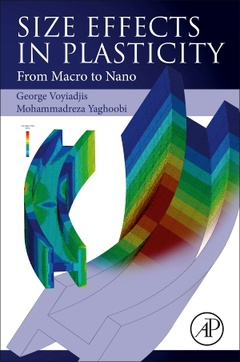Description
Size Effects in Plasticity
From Macro to Nano
Authors: Voyiadjis George, Yaghoobi Mohammadreza
Language: English
Subject for Size Effects in Plasticity:
208.67 €
In Print (Delivery period: 14 days).
Add to cart408 p. · 15x22.8 cm · Paperback
Description
/li>Contents
/li>Readership
/li>Biography
/li>Comment
/li>
Size Effects in Plasticity: From Macro to Nano provides concise explanations of all available methods in this area, from atomistic simulation, to non-local continuum models to capture size effects. It then compares their applicability to a wide range of research scenarios. This essential guide addresses basic principles, numerical issues and computation, applications and provides code which readers can use in their own modeling projects. Researchers in the fields of computational mechanics, materials science and engineering will find this to be an ideal resource when they address the size effects observed in deformation mechanisms and strengths of various materials.
1. Introduction: Size effects in materials2. Nonlocal continuum plasticity3. Nonlocal crystal plasticity4. Discrete dislocation dynamics5. Molecular dynamics6. Future evolution: Multiscale modeling framework to develop a physically based nonlocal plasticity model for crystalline materials
researchers and postgraduate students involved with the mechanics of materials (primarily those with mech eng backgrounds, but there will be some interest from materials science too). Also researchers in industry working on microstructure optimization
Voyiadjis’ primary research interest is in plasticity and damage mechanics of metals, metal matrix composites, polymers and ceramics with emphasis on the theoretical modeling, numerical simulation of material behavior, and experimental correlation. Research activities of particular interest encompass macro-mechanical and micro-mechanical constitutive modeling, experimental procedures for quantification of crack densities, inelastic behavior, thermal effects, interfaces, damage, failure, fracture, impact, and numerical modeling.
Dr. Voyiadjis’ research has been performed on developing numerical models that aim at simulating the damage and dynamic failure response of advanced engineering materials and structures under high-speed impact loading conditions. This work will guide the development of design criteria and fabrication processes of high performance materials and structures under severe loading conditions. Emphasis is placed on survivability area that aims to develop and field a contingency armor that is thin and lightweight, but with a very high level of an overpressur
- Provides a comprehensive reference on the field of size effects and a review of mechanics of materials research in all scales
- Explains all major methods of size effects simulation, including non-local continuum models, non-local crystal plasticity, discrete dislocation methods and molecular dynamics
- Includes source codes that readers can use in their own projects
These books may interest you

Elastoplasticity Theory 74.82 €



